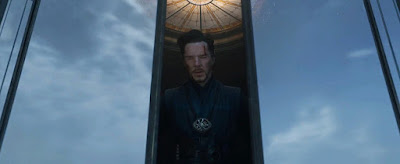One of the more interesting
superheroes to come out of Marvel Comics’ incredible burst or creativity during
the 1960s was Doctor Strange. First appearing in Strange Tales #110, he was the brainchild of idiosyncratic artist
Steve Ditko and was inspired by stories of black magic and the radio adventure
serial Chandu the Magician. The comic
book introduced the concept of mysticism into the Marvel Universe and, with its
surrealistic imagery, anticipated the psychedelic counterculture of the latter
part of the decade.
Doctor Strange (2016) is the 14th film of the
Marvel Cinematic Universe and continues the company’s successful formula that
has repeatedly made them box office darlings. Let’s face it, with a Marvel
movie you know exactly what you’re going to get and audiences take comfort in
that, especially during these uncertain times. While this movie does not divert
from their tried and true formula (if it ain’t broke…), they are finding new
ways to present it through inspired casting and impressive-looking visuals.
Stephen Strange (Benedict
Cumberbatch) is an arrogant and brilliant neurosurgeon whose life changes
radically when he gets into a car accident that damages his hands, rendering
him unable to perform surgeries. Benedict Cumberbatch is superb in these early
scenes as an egomaniac doctor reminiscent of Hugh Laurie’s conceited medical
profession on the popular television program House M.D. He’s not above humiliating a colleague (Michael
Stuhlbarg) he feels is beneath him while charming an attractive surgeon (Rachel
McAdams) and is very selective in the cases he takes on. Cumberbatch nails the
cool and aloof nature of Strange and is not afraid to portray him initially as
a conceited prick.
Devastated, Strange travels
to Nepal after meeting with a paraplegic man (Benjamin Bratt) that was
mysteriously healed at a place known as Kamar-Taj. He meets the enigmatic Mordo
(Chiwetel Ejiofor) who, in turn, introduces him to the Ancient One (Tilda
Swinton). She opens his eyes to a whole new world or, rather, worlds and
dimensions while also altering the way he sees things, like being able to exist
on the astral plane. The guided tour through the multiverse is a wonderfully
trippy sequence that fuses the philosophical mumbo jumbo of The Matrix (1999) with the
hallucinogenic imagery of 2001: A Space
Odyssey (1968).
Strange is also schooled in
the ways of the mystic arts that playfully blends aspects of the Harry Potter
movies (especially objects that have a life of their own) with period martial
arts movies from the 1970s. Not surprisingly, the brilliant man is a quick
learner, taking the initiative and figuring out how to astral project before
he’s taught how to do so.
Kaecilius (Mads Mikkelsen), a
former pupil of the Ancient One, and now a renegade sorcerer, has stolen pages
from one of her sacred tomes, which allows him to manipulate time. He wants to
draw power from the Dark Dimension and acquire eternal life by summoning the
powerful Dormammu. Naturally, a reluctant Strange is enlisted to stop Kaecilius
and save the world.
The most engaging Marvel
movies feature inspired casting choices and, in this respect, Doctor Strange excels with the casting
of Cumberbatch as Strange. He gets the self-importance of the character while
also displaying fantastic comic timing with the humorous observations that are
sprinkled lightly throughout the movie. With her otherworldly presence, Tilda
Swinton is ideally cast as the benevolent Ancient One, an immortal being that
protects the world from other dimensions but might not be as benign as she
appears to be. Chiwetel Ejiofor brings a quiet dignity to Mordo whose ideology
clashes with Strange’s own only for it to change when he discovers something
about the Ancient One late in the movie.
Doctor Strange is the first Marvel movie to use 3D
effectively as evident in an eye-popping sequence where Kaecilius and his
followers chase Strange and Mordo through the streets of New York City, bending
and manipulating matter so that buildings split apart and fold in on
themselves, taking a similar scene in Christopher Nolan’s Inception (2010) to a whole other level of complexity and scale. Furthermore,
in a nice touch, when Strange enters the Dark Dimension to have it out with
Dormammu, the filmmakers bring Ditko’s mind-altering artwork vividly to life. Along
with Guardians of the Galaxy (2014), Doctor Strange is the most visually rich
Marvel movie to date with a distinctive look that differentiates it from the
others.
It may be odd to say and not
really stretch if you think about it, but Doctor
Strange is also the most intellectual effort in the Marvel Cinematic
Universe – albeit in a superficial, popcorn movie kind of way, if that makes
any sense. There are several scenes that involve characters arguing or
expounding large chunks of dialogue about notions of time and space and the
dangers of manipulating them. While the movie features the requisite battles
between super-powered beings, it attempts to make them different visually from
other Marvel fare. To this end, Strange fights one of Kaecilius’ followers on
the astral plane while Rachel McAdams’ doctor tries to revive his physical
body. I also like that the climactic battle circumvents the traditional
slugfest by having our hero outwit the villain with his intellect. There’s a
lot to like about Doctor Strange and
I am curious to see where they go with this character.




No comments:
Post a Comment